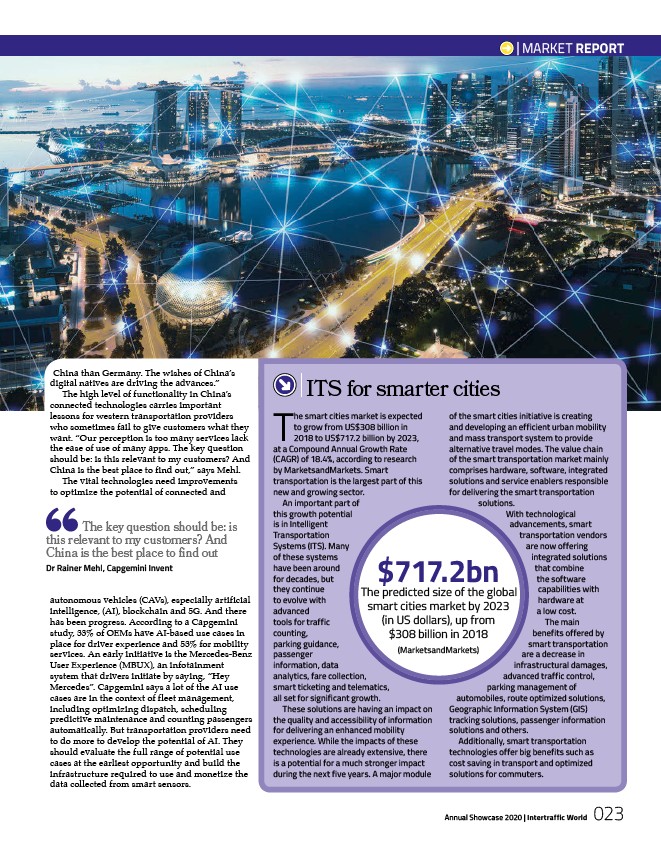
|MARKET REPORT
$717.2bn The predicted size of the global
smart cities market by 2023
(in US dollars), up from
$308 billion in 2018
(MarketsandMarkets)
Annual Showcase 2020 | Intertraffic World
023
China than Germany. The wishes of China’s
digital natives are driving the advances.”
The high level of functionality in China’s
connected technologies carries important
lessons for western transportation providers
who sometimes fail to give customers what they
want. “Our perception is too many services lack
the ease of use of many apps. The key question
should be: is this relevant to my customers? And
China is the best place to find out,” says Mehl.
The vital technologies need improvements
to optimize the potential of connected and
autonomous vehicles (CAVs), especially artificial
intelligence, (AI), blockchain and 5G. And there
has been progress. According to a Capgemini
study, 33% of OEMs have AI-based use cases in
place for driver experience and 53% for mobility
services. An early initiative is the Mercedes-Benz
User Experience (MBUX), an infotainment
system that drivers initiate by saying, “Hey
Mercedes”. Capgemini says a lot of the AI use
cases are in the context of fleet management,
including optimizing dispatch, scheduling
predictive maintenance and counting passengers
automatically. But transportation providers need
to do more to develop the potential of AI. They
should evaluate the full range of potential use
cases at the earliest opportunity and build the
infrastructure required to use and monetize the
data collected from smart sensors.
ITS for smarter cities
T he smart cities market is expected
to grow from US$308 billion in
2018 to US$717.2 billion by 2023,
at a Compound Annual Growth Rate
(CAGR) of 18.4%, according to research
by MarketsandMarkets. Smart
transportation is the largest part of this
new and growing sector.
An important part of
this growth potential
is in Intelligent
Transportation
Systems (ITS). Many
of these systems
have been around
for decades, but
they continue
to evolve with
advanced
tools for traffic
counting,
parking guidance,
passenger
information, data
analytics, fare collection,
smart ticketing and telematics,
all set for significant growth.
These solutions are having an impact on
the quality and accessibility of information
for delivering an enhanced mobility
experience. While the impacts of these
technologies are already extensive, there
is a potential for a much stronger impact
during the next five years. A major module
of the smart cities initiative is creating
and developing an efficient urban mobility
and mass transport system to provide
alternative travel modes. The value chain
of the smart transportation market mainly
comprises hardware, software, integrated
solutions and service enablers responsible
for delivering the smart transportation
solutions.
With technological
advancements, smart
transportation vendors
are now offering
integrated solutions
that combine
the software
capabilities with
hardware at
a low cost.
The main
benefits offered by
smart transportation
are a decrease in
infrastructural damages,
advanced traffic control,
parking management of
automobiles, route optimized solutions,
Geographic Information System (GIS)
tracking solutions, passenger information
solutions and others.
Additionally, smart transportation
technologies offer big benefits such as
cost saving in transport and optimized
solutions for commuters.
The key question should be: is
this relevant to my customers? And
China is the best place to find out
Dr Rainer Mehl, Capgemini Invent